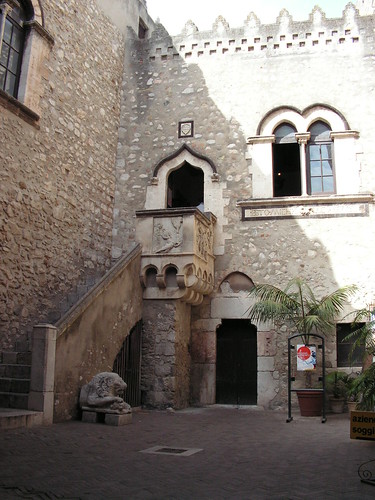31.10.06
30.10.06
Ave Maria

Photo: geo8
 Flickr
FlickrWhere: Scalinata di Santa Maria del Monte @ Caltagirone (CT)
History: the main landmark of Caltagirone is the 142-step monumental Staircase of Santa Maria del Monte, built from 1608 in the old part of the town; the peculiarity is that each step is decorated with different hand-decorated ceramics, using styles and figures derived from the millennial tradition of pottery making.
29.10.06
Counting sheeps
28.10.06
Too hot, baby
27.10.06
Summer carnival

Photo: agoinunpagliaio
 Flickr
FlickrWhere: Acireale (CT)
History: Acireale is undisputed "queen" of the Sicilian carnival.
Ten artisan yards feverishly work every year to prepare as many wagons that, on the occasion of the "more beautiful carnival of Sicily", they unthread stately in procession for the roads of the center, in an I exult of colors and imagination among thousand of people that fill the roads and the plazas of the city originating from the whole island.
26.10.06
The goodfellas
25.10.06
Dongione

Photo: references not found

Where: Adrano (CT)
History: a norman castle in the centre of the town, built in 1070 on behalf of Roger I; inside the castle is the archaeological museum with antique findings of the region.
24.10.06
Stazione Centrale
23.10.06
The old well
22.10.06
Granai

Photo: giambattista scivoletto

Where: Castello di Nelson - Bronte (CT)
History: the old granai, where the wheat was stocked.
21.10.06
The beauty of a courtyard
Photo: Gaetano Timpanaro

Where: the garden @ Castello di Nelson - Bronte (CT)
History: this is a former Benedictine abbey, built in the same place of the battles between the Saraceni and the troops of the general Maniace; inside there are a splendid garden and a small norman church dedicated to the Madonna di Maniace. Recently restructured, the castle works as a museum, while the old granai (where the wheat was stocked) became object of studies and a place to conferences.
20.10.06
The Castle #2
19.10.06
Cassata siciliana

Photo: pepperagusa
 Flickr
FlickrWhere: Everywhere :-) and to be honest, it is impossible to resist the spell of a tantalizing mixture of sponge cake, chocolate, sweetened ricotta, candied fruit, nuts and carefully decorated with thick icing or marzipan and covered with brightly colored candied fruits.
To celebrate my niece's 6th birthday.
Auguri, bambolina!
18.10.06
Chiesa di San Martino

Photo: Neil Weightman
 Flickr
FlickrWhere: Randazzo (CT)
History: rebuilt in the 17th century, it has a beautiful campanile dating from the 13th-14th century. Battlemented at roof level, a tall octagonal spire points skywards; lower down it is ornamented with elegant single openings, emphasized by deep polychrome strips and decorative pointed three-light windows. Inside, it preserves two Gaginian Madonnas and a polyptych attributed to Antonello de Saliba, a pupil of Antonello da Messina. Across from the church lie the ruins of the castle-prison, that began life in the 13th century as a fortified tower set into the city walls. Just beyond is the Porta di San Martino (St. Martin's Gateway).
17.10.06
Point of view
16.10.06
Beautiful sunset
15.10.06
Feast of San Giacomo

Photo: elskermeg
 Flickr
FlickrWhere: Caltagirone (CT)
History: on 24 - 26 July Caltagirone celebrates the feast of its patron (San Giacomo). Here circa 4.000 differently coloured paper lights illuminate the 142 steps of the scala di Santa Maria del Monte -- constructed in the 17th century to fulfil an important town-planning function and recently attributed World Heritage status by Unesco -- forming a tapestry of lights and creating enormous patterns, which are different on each occasion.
14.10.06
Look at the sky

Photo: MarianOne
 Flickr
FlickrWhere: Cathedral of Acireale (CT)
History: construction of the XVII-XVIII Century, with modern façade in Gothic style, ornate of a baroque portaland with an ample inside decorated with frescos of the '700.
13.10.06
The Castle

Photo: the daily growl
 Flickr
FlickrWhere: Acicastello (CT)
History: the Norman castle, which was built from 1076 to 1081, nowadays is a museum.
12.10.06
Black cat on black rocks
11.10.06
Ottobrata
10.10.06
Faraglioni

Photo: the daily growl
 Flickr
FlickrWhere: Acitrezza (CT)
History: apparently these rocks were hurled at Odysseus (called Ulysses in Latin) by the freshly-blinded cyclops.
9.10.06
U liotru

Photo: fazen
 Flickr
FlickrWhere: Piazza Duomo - Catania (CT)
History: the elephant, the symbol of the city, is probably from Roman times: it is a manufact in lava stone and surmounted by an obelisk. The names is perhaps a deformation of Heliodorus.
8.10.06
Palazzo Corvaja
7.10.06
Modern and ancient
 watching here right now
watching here right now
Do you wanna know where is Sicily?













